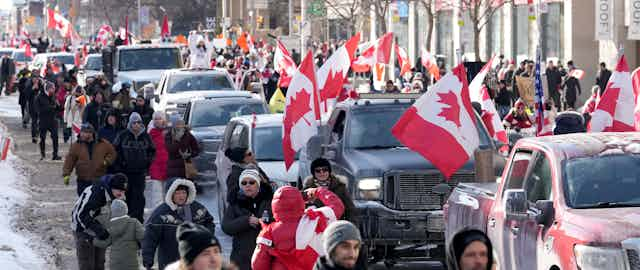Symbols matter to Canadians. As Canadian society has evolved, so too have the symbols that inspire our collective imaginations. It should come as no surprise that the “freedom convoy” has sparked conversation with their use of Canadian symbology.
There are Canadian flags (right side up and upside down), Donald Trump flags and provincial flags alongside known hate symbols — Confederate flags and swastikas — on the streets of cities and at border crossings across the country.
Their use of symbols is puzzling. Displaying insignia that stands in contradiction to the Canadian notion of freedom alongside the Canadian flag creates challenges in understanding the movement’s message.
Is the co-opting of Canadian symbols shaping a collective sentiment about how they are viewed? And how did Canada land on those symbols in the first place?
The Canadian flag
An important point worth raising is that the flag protesters are waving about is a relatively young flag. It was designed and adopted in 1965, after 1964’s Great Flag Debate. At the time, Canada was going through a national identity crisis.
A new flag had been decades in the making. It was seen as a controversial move, reflecting a lack of political will to replace the Union Jack or the Canadian Red Ensign, both of which had served Canada over the years.
It was so controversial that previous prime ministers had postponed the issue of selecting a new flag for Canada on several occasions. Even when the committee met to select the successful design, the issue was hotly contested until it was eventually resolved to meet the looming deadline of Canada’s 1967 centenary celebrations.
When the flag was raised on Parliament Hill for the first time, Prime Minister Lester B. Pearson read: “May the land over which this new flag flies remain united in freedom and justice … sensitive, tolerant and compassionate towards all.”
This new flag was designed to articulate Canada as a sovereign nation, no longer bearing the heraldry of a colonial past.
Inclusive and unified
The flag’s message about Canada as an inclusive, unified and just space has been debated since then — arguably more effectively than in Ottawa these past two weeks.
For many Indigenous Peoples, the symbolism of the Canadian flag is glaringly incommensurate with their colonial experience, a message that has been continuously contested through the development of flags of resistance and alternative imagery — like the Warrior Flag flown by members of the Kanien'kehà:ka community during the Oka Crisis.
Yet the Canadian flag, in another context, could be seen as reflecting reconciliation — flown at half-mast nationwide in remembrance of the children lost in residential schools. In this case, the national flag was used precisely because of its importance as a symbol of unity.

In contrast, the convoy’s efforts to appropriate national symbols and the Canadian imagination have proven ineffective.
While the jumbled host of flags used by this group is meant to reflect genuine grassroots spontaneity and a relatively small, though united and vocal presence, its effect is just the opposite. The efforts appear as incoherent as the set of symbols they have chosen to deploy in its cause.
The movement in its early days seemed in search of symbols. Parliament buildings, monuments and commemorative statues were all targeted. Part of the project included draping the statue of national hero Terry Fox – who spent his last moments on earth drawing attention to the critical role of scientific and health research — with paraphernalia in support of their cause.
Does the flag unite Canadians?
Has the flag outlived its specific use and intended specific political representation? Or will it be now seen as a symbol which has outlived its usefulness?
Will more and more Canadians become increasingly uncomfortable with its symbolic content after such public demonstrations and its association with such a toxic brand of nationalism?
Wondering if the previously inoffensive symbolism of the maple leaf flag will remain unscathed is not so far-fetched. Can any one symbol suit the purposes of both those who enforce and challenge state laws and regulations equally?
It is hard to know whether to be morally outraged at the trivialization of the hard-won freedoms that the “freedom convoy” has perpetuated, or simply dumbfounded by the sheer nonchalance of the protesters choice of symbolism. For most Canadians, I suspect that it is a little of both.
In the School for the Study of Canada at Trent University, scholars delve into critical examinations across a range of themes — environment, nationalism, sovereignty, Indigeneity, diversity and immigration — exploring the Canadian identity and Canada’s role in the world today. This includes exploring how current issues, including the “freedom convoy”, are perceived by Canadians and people around the world.
The flag Canada first raised in 1965 was a symbol used to unite Canadians as a shared nation — an exciting new symbol that Canadians were proud of.
Feb. 15 marks Flag Day in Canada, and so perhaps this is a good time to ask ourselves if this is still true? Does the flag unite Canadians, or confuse them as its symbolism is used to different ends and causes? Can any symbol really speak for all of us?
Perhaps what will come of this moment in Canadian history is a new set of symbols, arguably not perfect and not uncontested, but reflective of our times.

